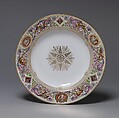Soup plate
Manufactory Sèvres Manufactory French
Designer Jean-Charles François Leloy
Attributed to Antoine-Louis Bouvrain
Not on view
Louis-Philippe was a great patron of the Sèvres factory, and among his many orders were commissions for dinner services for each of his official residences. This soup plate comes from a dinner service ordered for the château at Fontainebleau. The order was initiated by the king in 1836, and the first pieces of the service were delivered to Fontainebleau in 1839. Deliveries continued through the early 1840s, and the service was augmented by additional orders made through 1847; it is to this last order that this soup plate belongs.
The service was designed with two different, though complementary, border designs, and the design seen here is the more dense and complex of the two. It is comprised of arabesques of foliage with oval reserves containing emblems and diamond-shaped reserves enclosing the royal cipher. Louis-Philippe's initial order for the service had specified that it "would bear a bas-relief in the Renaissance style," a direct reference to the château's Renaissance origins and distinctive character. The service as finally designed did not specifically reflect the king's request, but the leafy borders recall the nearby extensive forest, and the animals entwined in the foliage allude to the hunting for which the château was famous.
Due to rights restrictions, this image cannot be enlarged, viewed at full screen, or downloaded.

